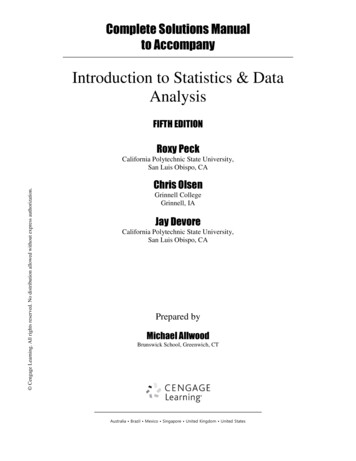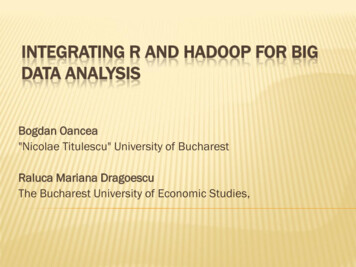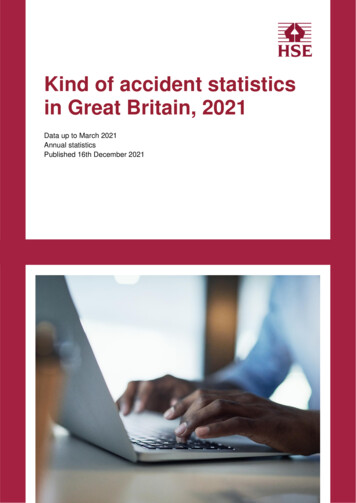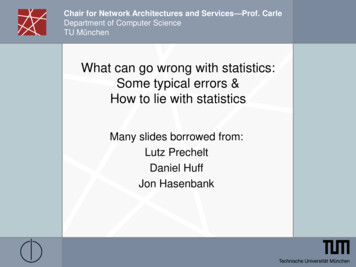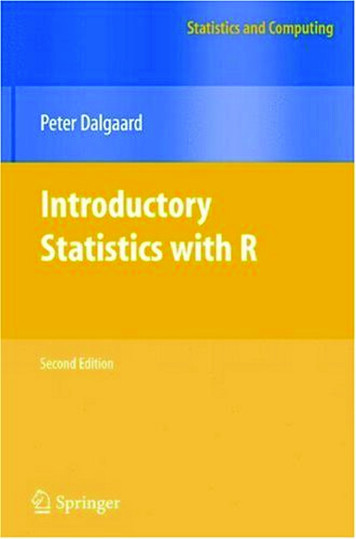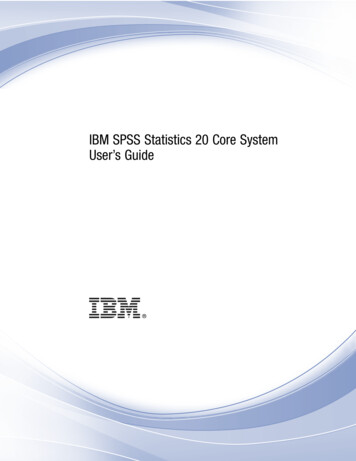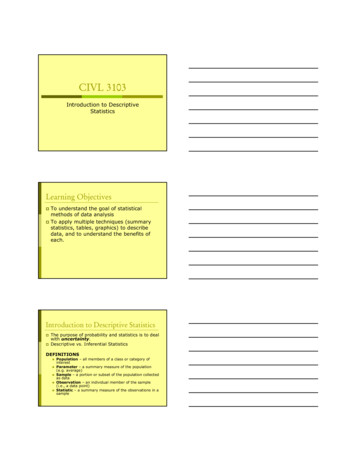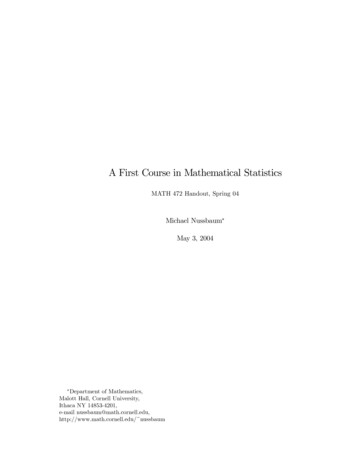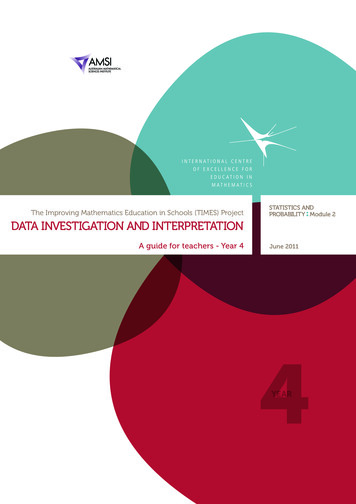
Transcription
The Improving Mathematics Education in Schools (TIMES) ProjectSTATISTICS ANDPROBABILITY Module 2DATA INVESTIGATION AND INTERPRETATIONA guide for teachers - Year 4June 20114YEAR
Data Investigation and Interpretation(Statistics and Probability : Module 2)For teachers of Primary and Secondary Mathematics510Cover design, Layout design and Typesetting by Claire HoThe Improving Mathematics Education in Schools (TIMES)Project 2009‑2011 was funded by the Australian GovernmentDepartment of Education, Employment and WorkplaceRelations.The views expressed here are those of the author and do notnecessarily represent the views of the Australian GovernmentDepartment of Education, Employment and Workplace Relations. The University of Melbourne on behalf of the InternationalCentre of Excellence for Education in Mathematics (ICE‑EM),the education division of the Australian Mathematical SciencesInstitute (AMSI), 2010 (except where otherwise indicated). Thiswork is licensed under the Creative Commons AttributionNonCommercial-NoDerivs 3.0 Unported nd/3.0/
The Improving Mathematics Education in Schools (TIMES) ProjectSTATISTICS ANDPROBABILITY Module 2DATA INVESTIGATION AND INTERPRETATIONA guide for teachers - Year 4June 2011Helen MacGillivray4YEAR
{4}A guide for teachersDATA INVESTIGATIONAND INTERPRETATIONASSUMED BACKGROUNDIt is assumed that in Years F-3, students have had learning experiences involving choosingand identifying simple questions from familiar situations that involve gathering informationand data in which observations fall into simple, natural categories. It is assumed thatstudents have had learning experiences in recording, classifying and listing such data, andhave seen and used tables, picture graphs and column graphs of categorical data withsimple, natural categories.MOTIVATIONStatistics and statistical thinking have become increasingly important in a society thatrelies more and more on information and demands for evidence. Hence the need todevelop statistical skills and thinking across all levels of education has grown and is of coreimportance in a century which will place even greater demands on society for statisticalcapabilities throughout industry, government and education.A natural environment for learning statistical thinking is through experiencing the processof carrying out real statistical data investigations from first thoughts, through planning,collecting and exploring data, to reporting on its features. Statistical data investigationsalso provide ideal conditions for active learning, hands-on experience and problemsolving. Real statistical data investigations involve a number of components: formulating a problem so that it can be tackled statistically; planning, collecting, organising and validating data; exploring and analysing data; and interpreting and presenting information from data in context.A number of expressions to summarise the statistical data investigative process have beendeveloped but all provide a practical framework for demonstrating and learning statisticalthinking. One description is ‘Problem, Plan, Data, Analysis, Conclusion (PPDAC)’; another is‘Plan, Collect, Process, Discuss (PCPD)’.No matter how it is described, the elements of the statistical data investigation process areaccessible across all educational levels.
The Improving Mathematics Education in Schools (TIMES) ProjectCONTENTIn this module, we consider, in the context of statistical data investigations, datawhere each observation falls into one of a number of distinct categories. Such dataare everywhere in everyday life. Some examples are: gender direction on a road type of dwellingData of this type is called categorical data.Sometimes the categories are natural, such as with gender or direction on a road,and sometimes they require choice and careful description, such as type of dwelling.Another type of data situation in which each observation falls into one of a distinctnumber of categories is count data. Each observation in a set of count data is a countvalue. Count data occur in considering situations such as: the number of children in a family the number of children arriving at the tuckshop in a 5 minute interval the number of taxis waiting at a taxi rank at a selected point of time the number of TV sets owned by a family.Count data in which only a small number of different counts are observed can also betreated as categorical data, particularly for the purposes of data presentations.This module considers statistical data investigations involving categorical data and countdata. In the situations described in this module count data is treated as categorical databecause of it involving a small number of different values of counts.The focus in the exploration and interpretation phases is on data with just one set ofcategories, even if the questions or issues of interest involve more than one possible set ofcategories. That is, a topic of interest may involve both type of dwelling and number of petsin a family, but in exploring and interpreting, this module focuses on each of these in turn.{5}
{6}A guide for teachersThis module uses three examples to develop the statistical data investigation processthrough the following: considering initial questions that motivate an investigation; identifying issues and planning; collecting, handling and checking data; exploring and interpreting data in context.The phases lend themselves to representation on a diagram, as follows.Initial questionIssues andplanningExploring andinterpreting datain contextCollecting,handling,checking dataINITIAL QUESTIONS THAT MOTIVATE AN INVESTIGATIONThe following are some examples of questions that involve collecting and investigatingcategorical data or data involving a small number of different values of counts.A Do you have a pet? What type of pet is it? Is the pet yours or a family pet?Does your family have more than one pet? How many pets do families tendto have? Are cats more popular than dogs?B What colours of cars tend to be in your neighbourhood? Are there big cars or smallcars? What are the most popular colours for cars? Grey has become a very popularcolour for cars – is it more popular than white?C How many different colours are there in Smarties or M&M’s? What is your favouritecolour? Do packets of Smarties or M&M’s tend to contain about the same numberof each colour?These are examples of just some of the many questions that can arise involvingcategorical data. These questions are used here to explore the progression ofdevelopment of learning about data investigation and interpretation.
The Improving Mathematics Education in Schools (TIMES) ProjectGeneral statistical notes for teachersIdentifying and describing categoriesCategorical data are data in which each observation falls into one and only one category.The categories are usually natural categories such as cat or dog, male or female, but oftenthere are many possible categories or different possible descriptions. If so, we need tocarefully choose our groupings and descriptions of them. Colour is usually categoricalunless we are being scientific and describing colour by a scientific measure. In Example Cabove, the colours are chosen and fixed for us. However, in Example B, the investigatorswill need to decide what colour groupings they are going to use and describe thesecarefully so that the data collected are consistent and reliable. The description must alsobe clear for anyone listening to, or reading, a report of the investigation.Some categorical data need careful description of their categories. For example, period ofa day could be described as peak or off-peak; day or night; morning, afternoon, evening,night. A person’s age group could be described as child, teenager, adult. These examplesalso illustrate that many sets of categorical data come from creating or imposingcategories for data such as time or age (which is itself time of course).General statistical notes for teachersCount dataEach observation in a set of count data is a count value. Hence count data occur onlyin situations such as observing the number of children in a family, the number of TV setsowned by each family. Note that age does not a give count data because it has units(years or months or weeks or days etc).Some count data sets have many different observed values, such as number of people atfootball matches collected over a season, but some have only a few different observedvalues, such as number of dogs owned by city-dwelling families. Count data with onlya few different observed values are often presented using the graphs developed forcategorical data.IDENTIFYING ISSUES AND PLANNINGIn this first part of the data investigative process, one or more questions or issues beginthe process of identifying the topic to be investigated. In thinking about how to investigatethese, other questions and ideas can tend to arise. Refining and sorting these questionsand ideas along with considering how we are going to obtain data that is needed toinvestigate them, help our planning to take shape. A data investigation is planned throughthe interaction of the questions: ‘What do we want to find out about?’ ‘What data can we get?’ and ‘How do we get the data?’{7}
{8}A guide for teachersEXAMPLE A: PETSThe general topic is investigating domestic or family pets. The questions above are justsome that may arise in a free discussion. On the surface, this topic may seem simple butthere are many aspects of it to be considered before a data investigation can be undertaken.Some questions that need to be considered include, what sort of pets are we going toconsider, and are we going to consider pets of the families with a child in Year 4 at thisschool, or are we going to consider more than just one class or one year level.Students need to decide what can be called a pet even if they do not choose categoriesbefore collecting the data. For example, they may decide that a pet must be a livinganimal (so that pet rocks or inanimate pets are not considered) and that to be classified asa pet, an animal must be fed by the family, housed in the precinct of the family home andparticipate in some way with members of the family. Students living in rural or agriculturalareas may need to discuss this carefully before deciding what can be classified as a pet.Another type of consideration that comes under both identifying the issues or questionsand in the planning, is on whom or what are we going to collect these data. The dataare most likely collected from students, whether restricted to one class or year level orwhether other classes or year levels are involved. Which ‘family’ to consider in the case ofdual families needs to be clear. If more than one class or year level provides information,care will be needed to avoid double-counting of families with siblings at the school.Notice that by considering pets as belonging to families, we avoid the difficulty of whatwould we mean by an individual student at this year level ‘owning’ a pet.Next we need to consider what data we are going to collect. We could just ask for thenumber of pets in total, or we could ask for numbers of different types of pets, or wecould simply ask for a listing of pets per family and then the students can decide how toclassify the pets once the data are collected. It is likely that students will be interested inthe various types of pets of the families of their classmates, so a listing of pets per familymay be the best raw data to collect.EXAMPLE B: CARSThe general topic is colour of cars. As with pets, there are many aspects of this topic thatneed discussion and decisions. The first is, what do we mean by a ‘car’? Are we going toinclude all types of vehicles or not consider trucks, buses, motor bikes etc? This is up tothe students and their teacher – the important point is to make sure that those collectingthe data are clear about what to observe and that it is described clearly in any reporting.We need to decide where we are going to collect the data. They could be collected byobservation of cars passing the school, or of cars parked in a large carpark, or by a surveyof students reporting the colour of the car or cars owned by their family. Only one ofthese ways should be used to avoid doubling counting (or even triple counting!) and eachway may or may not represent slightly different general situations. This last point can beraised even at such early stages of development.
The Improving Mathematics Education in Schools (TIMES) ProjectColour of cars is not straightforward, and, unlike the pet example, how to recordcolours must be worked out before the data are collected in order to obtain consistentdata. Although there might be many opinions offered by students, at this early stage ofdevelopment, some simple classifications could be selected, such as: white; black; grey orsilver; all reds, yellows, browns; all blues, greens, purple.EXAMPLE C: M&M’S OR SMARTIESThe general topic is colour of Smarties (or M&M’s). This is the simplest of the threeexamples here from the point of view of what to observe. The same type of sweet wouldbe observed (e.g. not peanut ones) and the colours are set by the manufacturer. Onedecision that is needed is what size packet to buy and whether to look at colours in eachpacket with a number of different packets or whether just to look at one large number ofsweets. However comparing summaries of colours observed over different packets of thesame size provides an introduction to concepts of variation over samples – in this case,samples of sweets. In this example, the colours could be recorded separately for eachpacket and then the data could be combined overall.General statistical notes for teachersEach of the above examples demonstrates key statistical aspects of the initial phases ofdata investigations in illustrating how initial ideas lead to questions to be investigated which then lead to identificationof what is to be collected or observed identification of the ‘subjects’ – on what will the data be observed or collected early considerations of what the data represent.Planning a statistical investigation involves identification of what is to be observed (whatdata are we going to collect) and the ‘subjects’ or ‘experimental units’ of the investigation– that is, on what are we are going to collect or observe our data?The ‘what’ we are going to observe is called a statistical variable.In Example B, the ‘subjects’ are cars, and the variable of interest is ‘colour of car’. We couldsummarise our plan by the sentence, ‘The cars passing the school will be classified bytheir colour’.In Example C, the ‘subjects’ are individual sweets, and the variable of interest is colourof the sweet. We could summarise our plan by the sentence, ‘Each sweet in a packet ofM&M’s will be classified by its colour’.{9}
{10}A guide for teachersCOLLECTING, HANDLING AND CHECKING DATAEXAMPLE A: PETSFor the example on pets, if the data are collected by listing all pets, the recording formmight look like this:STUDENT NAMEFAMILY NAMEPETSAbigailJonesDog, 2 birdsFredSmith2 mice, tortoiseJennyNguyenCatIf the classifications of pets are chosen before the data are collected, the recording formmight look like lJones1020FredSmith0003JennyNguyen0100From either form, the total number of pets for each family is readily obtained. If the dataare originally collected according to the first recording form above, then how to group thedata will need to be considered if it is wished to produce a table like the second above.If the data are collected on the families of the students in the class(es) which discussedthe investigation, they will be aware of the decisions of what is a pet, and what is a family.However, the students should express it in their own words for inclusion in reporting.If the data are collected from other students or classes, the students collecting the dataneed to have an agreed form of words when asking other students. A trial/rehearsal of thisis advisable for both confidence and consistency – and for fun!Note that because of recording the student’s and family’s name, the number of pets offamilies for boys and girls in Year 4 could be considered separately if a reasonably sizeddataset is collected.
The Improving Mathematics Education in Schools (TIMES) ProjectEXAMPLE B: COLOURS OF CARSAny data collection carried out in real time requires trialling of collection. In the case ofrecording colours of cars that drive past a school or other convenient location, studentscould work in groups of three, with one student calling out the colours and the other two,each with a recording sheet, ticking the appropriate column. If cars pass fairly frequently,some groups of students could record the cars in one direction, and other groups dothe other direction. The purpose of two recorders per ‘caller’ and more than one grouprecording the same data is for checking purposes. This will illustrate to the students howeasy it is to make a recording mistake.Thus a recording sheet might look RPLE A preliminary ‘pilot’ by the students might result in change to groupings of colours.For example, the students might want to separate red from the third grouping above.EXAMPLE C: COLOURS OF SMARTIES OR M&M’SBecause these data are simple to collect, the recording sheet can be a final table ofnumbers of each colour, or students can use an intermediate stroke-and-cross recordingform, such asGreenPurpleRedEach packet of sweets could be referenced by a student’s name or by an assigned number.{11}
{12}A guide for teachersGeneral statistical notes for teachersThe form of recording sheets tends to depend on the practicalities of the investigation.Usually the rows of the recording sheet correspond to the ‘subjects’.In Example A, the ‘subjects’ are families, identified by the child who is representing thefamily. The second form of the recording sheet is recording the numbers of dogs, cats,birds and ‘other’ pets for each family. From this, the total number of pets for each familycan be obtained.In Example B, the ‘subjects’ are cars and each row of the recording sheet corresponds toa car. There is only one variable, colour, but because it is difficult to write down a colouror even a letter quickly, the recording sheet can be designed for convenience in quickrecording by just requiring a tick. If this was part of a larger investigation, the data collectedby the above recording sheet should be then converted to a sheet containing one columnthat records the colour category by name.In Example C, the ‘subjects’ are individual sweets. The raw data would be a single columnin which each sweet would be classified by its colour. Because this is tedious in this simplesituation, the stroke-and-cross method can be used to bypass the raw recording sheet togo straight to obtaining the summary data.EXPLORING AND INTERPRETING DATAIt is in exploring data that we use presentations, including graphical andsummary presentations.Categorical data are summarised by the number of observations that fall in each category.These are called the frequencies of the data – how often did each category occur. Thesefrequencies can be presented in a table or can be graphed by a column graph in whicheach category has a column and the heights of the columns represent the frequency ofthe observations that fall in that category.Count data are also summarised by the number of observations that fall in eachcategory, where the categories correspond to the different possible count values that theobservations take.Thus frequency of a category is the numbers of observations in the data that fall into thatcategory. It is frequencies that provide the information on how likely are the differentcategories. A similar statement for values of counts can be made.Column graphs are also called barcharts.
The Improving Mathematics Education in Schools (TIMES) ProjectGeneral statistical notes for teachersIf count data take many different values, with frequencies of only one to three for eachvalue, presenting the data in a table or column graph gives very little idea of what the datalook like. But count data with a small number of distinct values can be presented wellby using a column graph. Also, as is seen in Example A below, for count data with mostobservations taking only a few different values, the remaining infrequent values are oftengrouped together.EXAMPLE A: PETSThere are a number of possible ways of considering these raw data.The focus could be on number of pets per family, in which case the data are presentedeither in a table or as a column graph with frequency of families that own 0 pets, 1 pet, 2pets etc. For example, a table of data collected from 50 families could look like thisNUMBEROF PETSFREQUENCYOF FAMILIES0123More than 35181296The corresponding column graph or barchart looks like this.GRAPH OF NUMBER OF PETS2015FREQUENCY10500123more than 3NUMBER OF PETSThe graph shows that only 5 of the 50 families have no pets and the most commonnumber of pets for a family to have in the data for these 50 families is 1, but more thanhalf the 50 families have more than 1 pet.Similarly, we could look at a particular type of pet, such as dogs or cats.To consider the question of whether dogs are more popular than cats, are we asking ifa family is more likely to own a dog than a cat? If so, each family could be classified asowning at least 1 dog but no cats, owning at least one cat but no dogs, owning both orowning neither. A possible graph of this is shown below. It shows that there is almost nodifference in popularity of dogs and cats as pets for these 50 families, and that both arevery popular, with more than 10 out of the 50 families owning both.{13}
A guide for teachersGRAPH OF CAT OR DOG1816141210FREQUENCY86420bothcatdogneitherCAT OR DOGEXAMPLE B: COLOURS OF CARSFrom the form of the recording sheets above, it is a simple matter to obtain the frequenciesof the different colours. Checks can then be made across recording sheets within eachgroup and across groups. Differences of one or two totals for each colour are probably notworth checking, but if there are big differences, recording sheets can be compared.GRAPH OF COLOUR OF LOWBROWNWHITECOLOURA column graph of the car colours could look like the one shown above. This showsthat white is the most common colour in these data, closely followed by the group thatincludes red, yellow, brown. Perhaps putting all those colours in one group was not agood choice! The group of blues and greens is next but much less popular, and therewere very few black cars passing on that day.
The Improving Mathematics Education in Schools (TIMES) ProjectEXAMPLE C: COLOURS OF SMARTIES OR M&M’SAs with the colours of cars, the numbers of sweets of each colour can be presented intables or column graphs. It is easily seen how valuable the column graphs are for ‘seeing’what the data are like and, in an example like this, for comparing colour frequencies indifferent packets of sweets. Below are column graphs of colours of M&M’s in 6 differentpackets. Note that the scale of the column graphs is the same so that we can easilycompare the frequencies of colours within and across packets.121088662PACKET 1PACKET 2GRAPH OF PACKET 3GRAPH OF PACKET 4121088662PACKET 3PACKET 4GRAPH OF PACKET 5GRAPH OF PACKET NBLUEPACKET H OF PACKET 210BLUEFREQUENCYGRAPH OF PACKET 1PACKET 6These graphs demonstrate well the amount of variation in frequencies of colours therecan be across packets, even if overall the manufacturers use a fixed set of proportions ofcolours. [Aside: in this example, the overall fixed percentages of the different colours fromwhich these data were obtained was: 24% blue; 14% brown; 16% green; 20% orange; 13%red; 14% yellow.]{15}
A guide for teachersPutting all the packets together gives the following column graph.GRAPH OF ALL ENCY{16}ALL PACKETSBelow is a picture graph of data on colours of 180 sweets with each picture of a sweetrepresenting 4 sweets in the data. Thus there are 40 blue sweets, 32 brown and 32 orangesweets, 28 green sweets, and 24 each of red and yellow sweets.BLUEBROWNGREENORANGEREDYELLOWThe students might also like to nominate their favourite colour to compare theirpreferences with each other and with the most frequently occurring colours in their data.Each student says their favourite colour, and a column graph presents the number ofstudents nominating each colour.SOME GENERAL COMMENTS ANDLINKS FROM F-3 AND TOWARDS YEAR 5In the above examples B and C, the variable ‘colour’ is a categorical variable. In ExampleA, the variable ‘number of pets per family’ is a count variable but because it mostly takessmall values, it is being treated here as a categorical variable, with the last category being 4or more pets.Type of pet is a categorical variable, and the data in Example A could be considered astype of pet. How to treat the data in Example A depends on whether the focus is on petsin a family or on a collection of pets obtained by surveying a number of families. Howeverit is difficult to consider what such a collection of pets would be representative of,whereas the collection of families is representative of families of Year 4 (or primary schoolif data collected over all Year levels) in the type of region of the school.
The Improving Mathematics Education in Schools (TIMES) ProjectAlthough simple categorical data are used in Years F-3, the above material marks thefirst experiences in the process of statistical data investigations. The focus has been onconsidering just one categorical variable at a time, so that the only types of presentationsare tables and column graphs with just one set of categories. In this relatively simplesituation the above examples illustrate the extent of statistical thinking involved in the initialstages of an investigation in identifying the questions/issues and in planning and collectingthe data.The three examples of the module can demonstrate concepts such as ‘what do our datarepresent’ and variation in data across samples. Variation in data across samples tendsto arise naturally in everyday situations that are very familiar to young students. Theseconcepts are further developed as students progress.In Year 5, we extend the concepts of types of data to consider measurement data andmore general situations with count data. In Year 5, although questions and issues mayinvolve more than one variable, the focus is on exploring and interpreting phases of theinvestigation process with one variable at a time.{17}
The aim of the International Centre of Excellence forEducation in Mathematics (ICE-EM) is to strengtheneducation in the mathematical sciences at all levelsfrom school to advanced research and contemporaryapplications in industry and commerce.ICE-EM is the education division of the AustralianMathematical Sciences Institute, a consortium of27 university mathematics departments, CSIROMathematical and Information Sciences, the AustralianBureau of Statistics, the Australian Mathematical Societyand the Australian Mathematics Trust.The ICE-EM modules are part of The ImprovingMathematics Education in Schools (TIMES) Project.The modules are organised under the strandtitles of the Australian Curriculum: Number and Algebra Measurement and Geometry Statistics and ProbabilityThe modules are written for teachers. Each modulecontains a discussion of a component of themathematics curriculum up to the end of Year 10.www.amsi.org.au
{6} A guide for teachers This module uses three examples to develop the statistical data investigation process through the following: considering initial questions that motivate an investigation; identifying issues and planning; collecting, handling and checking data; exploring and interpreting data in context. The phases lend themselves to representation on a diagram, as follows.
